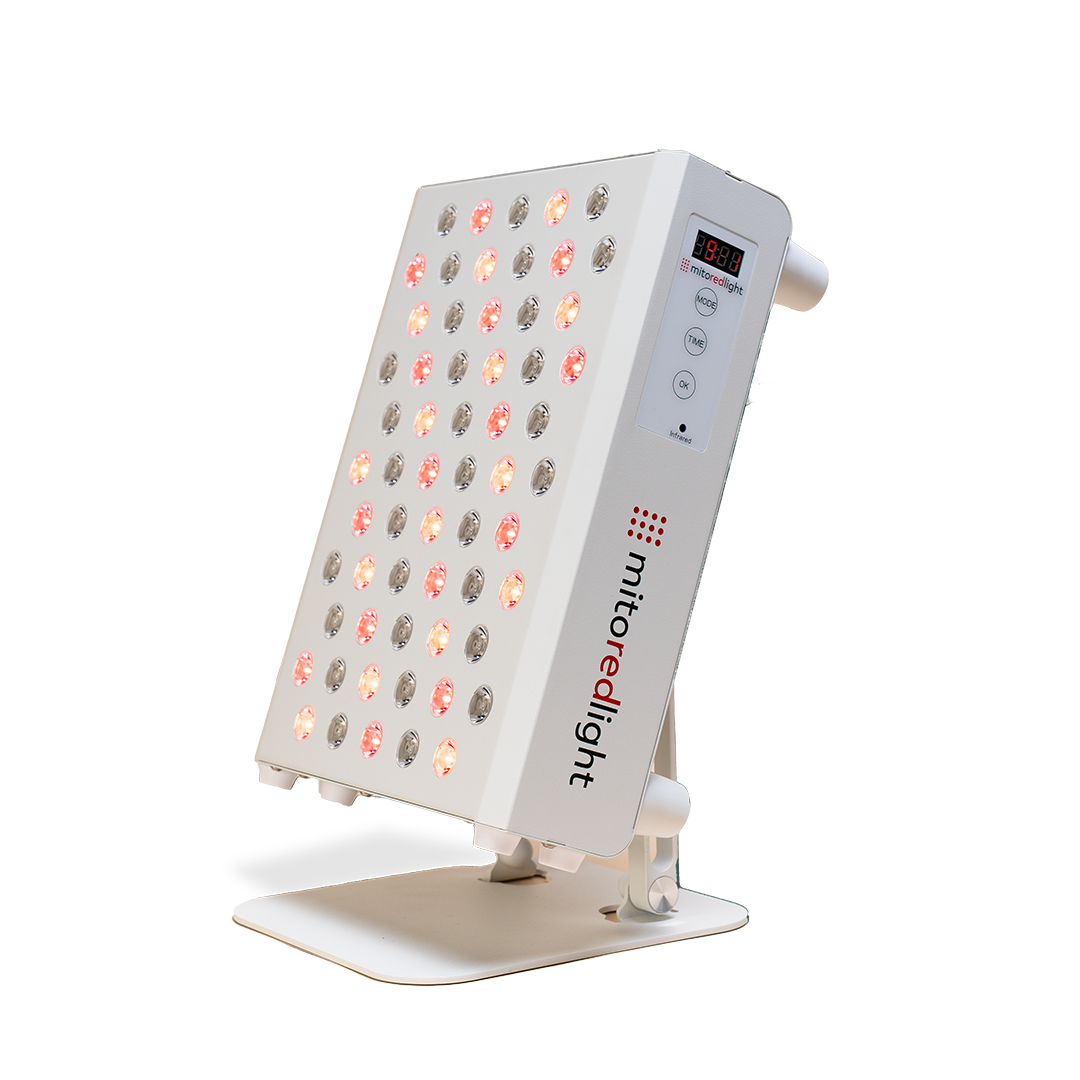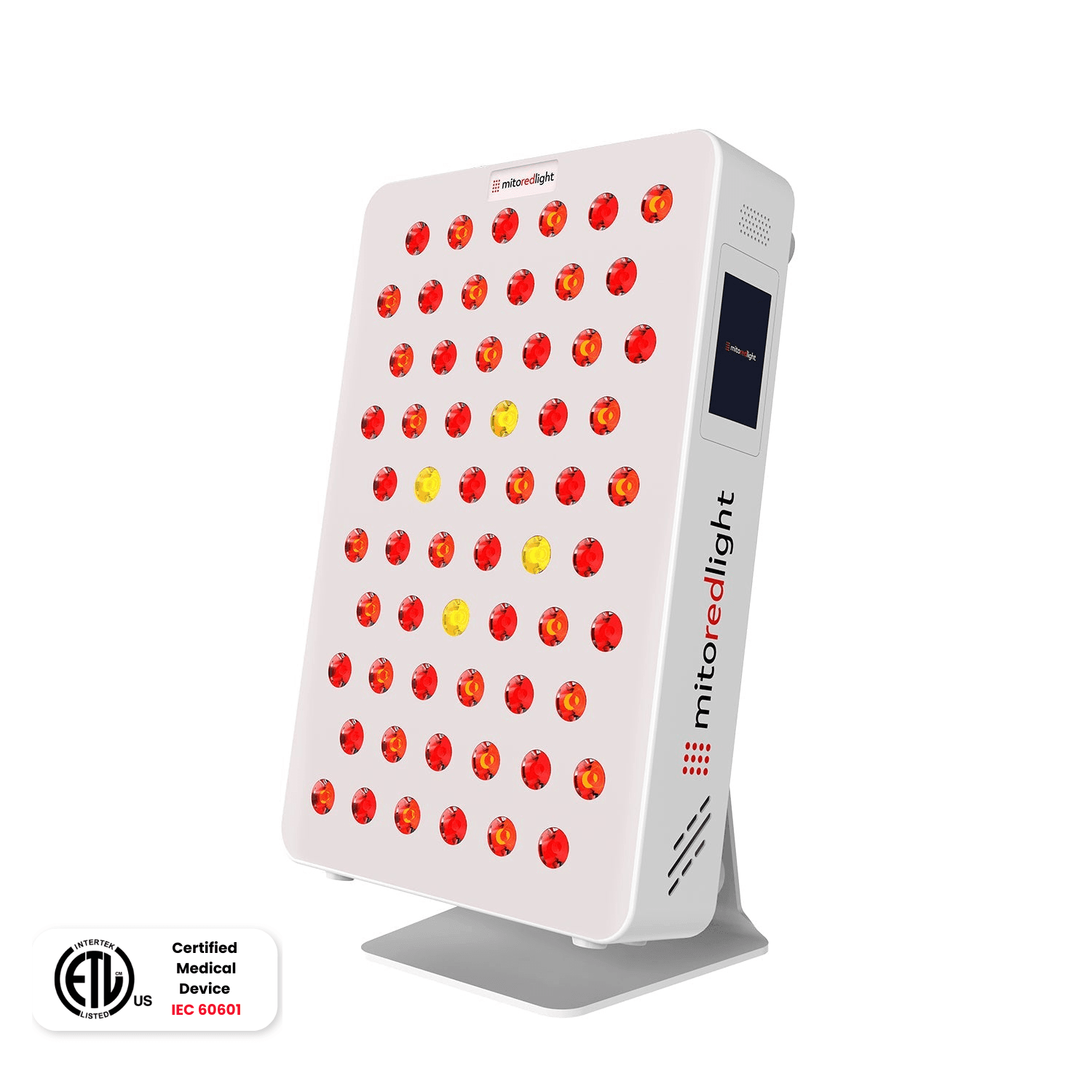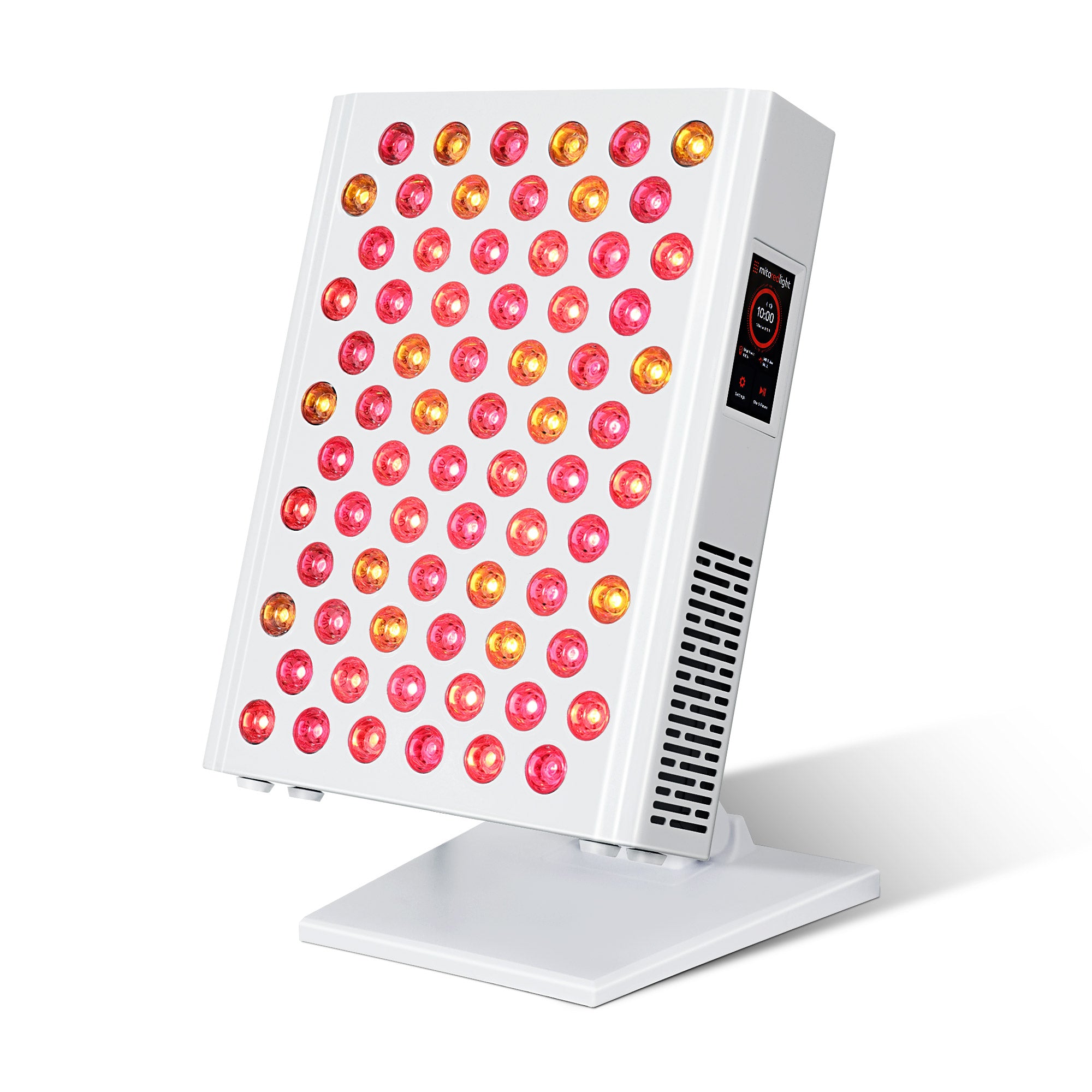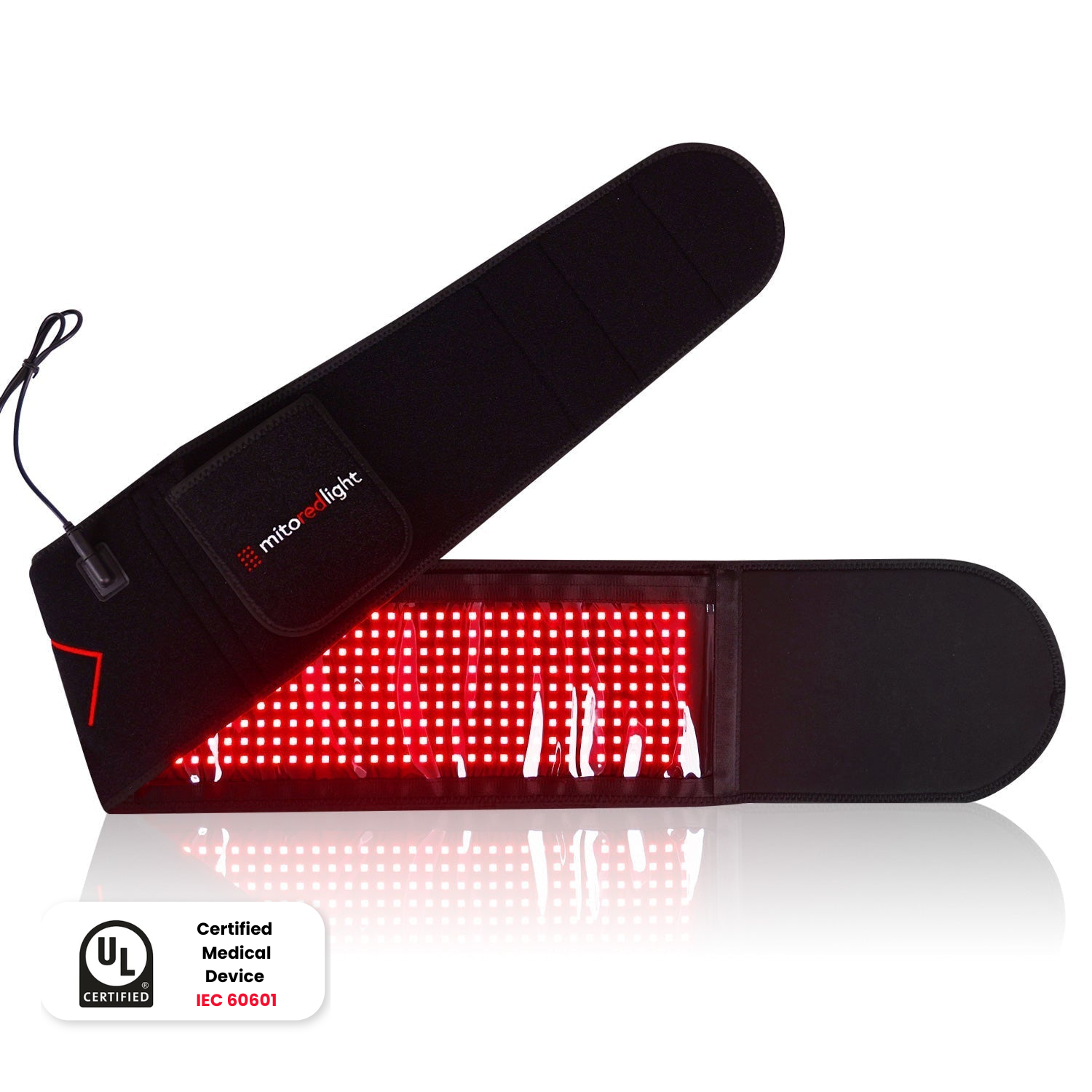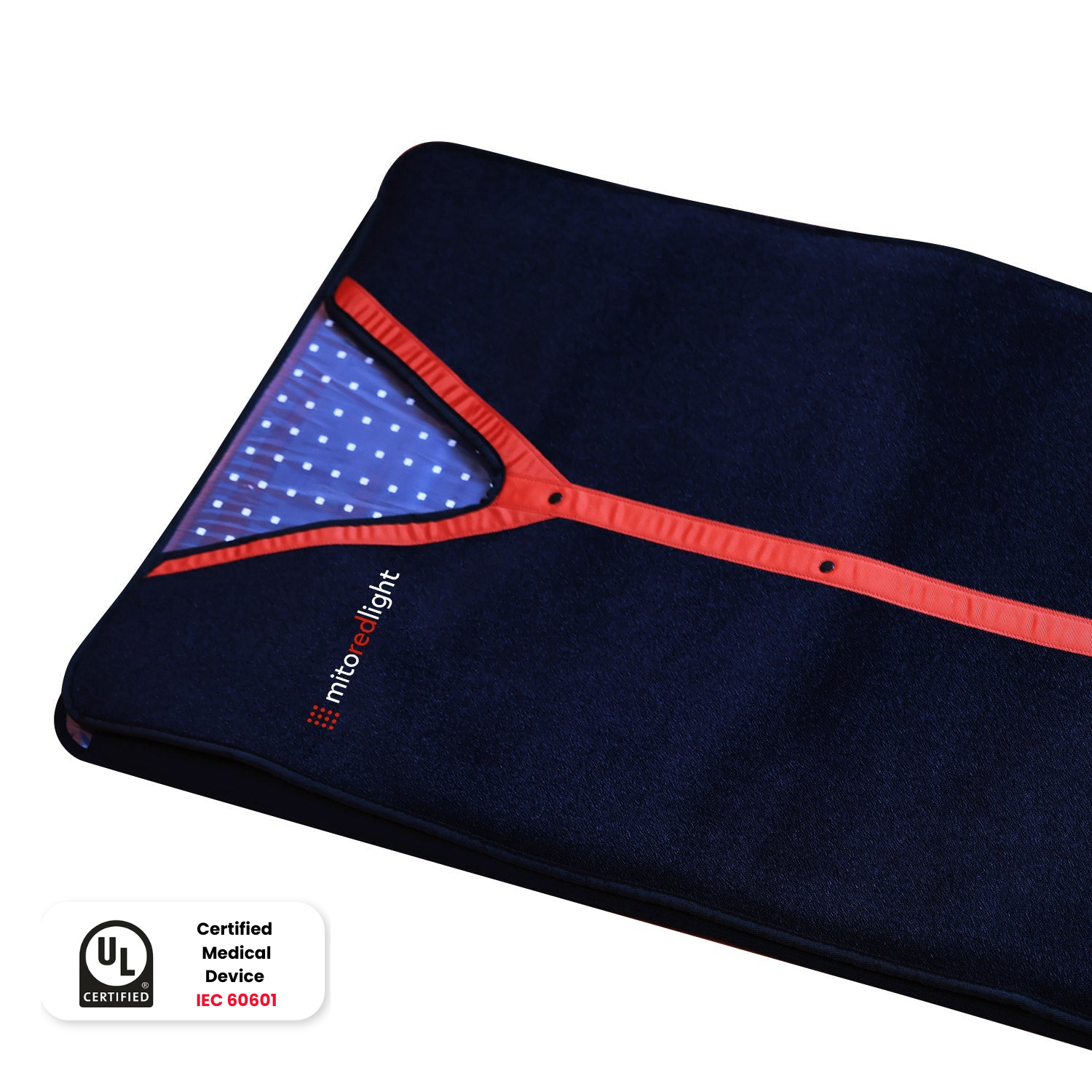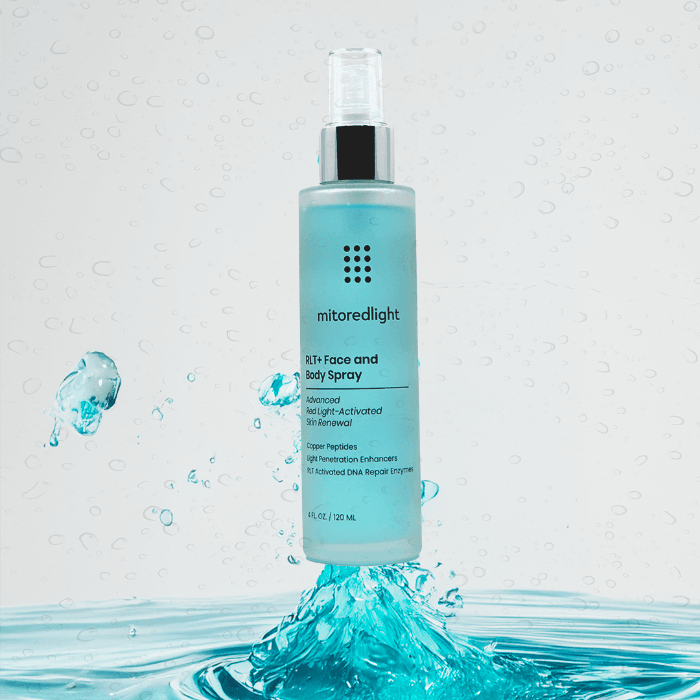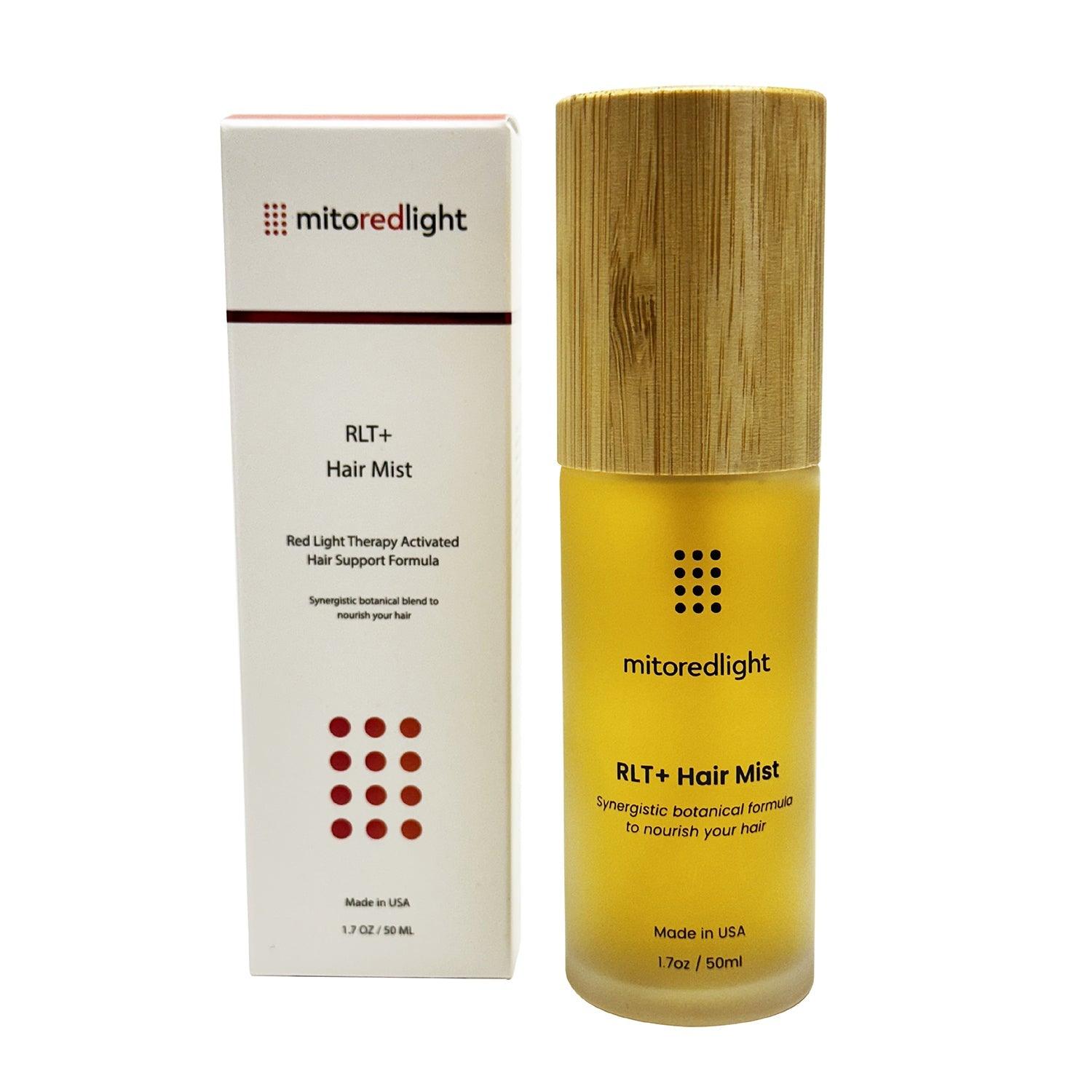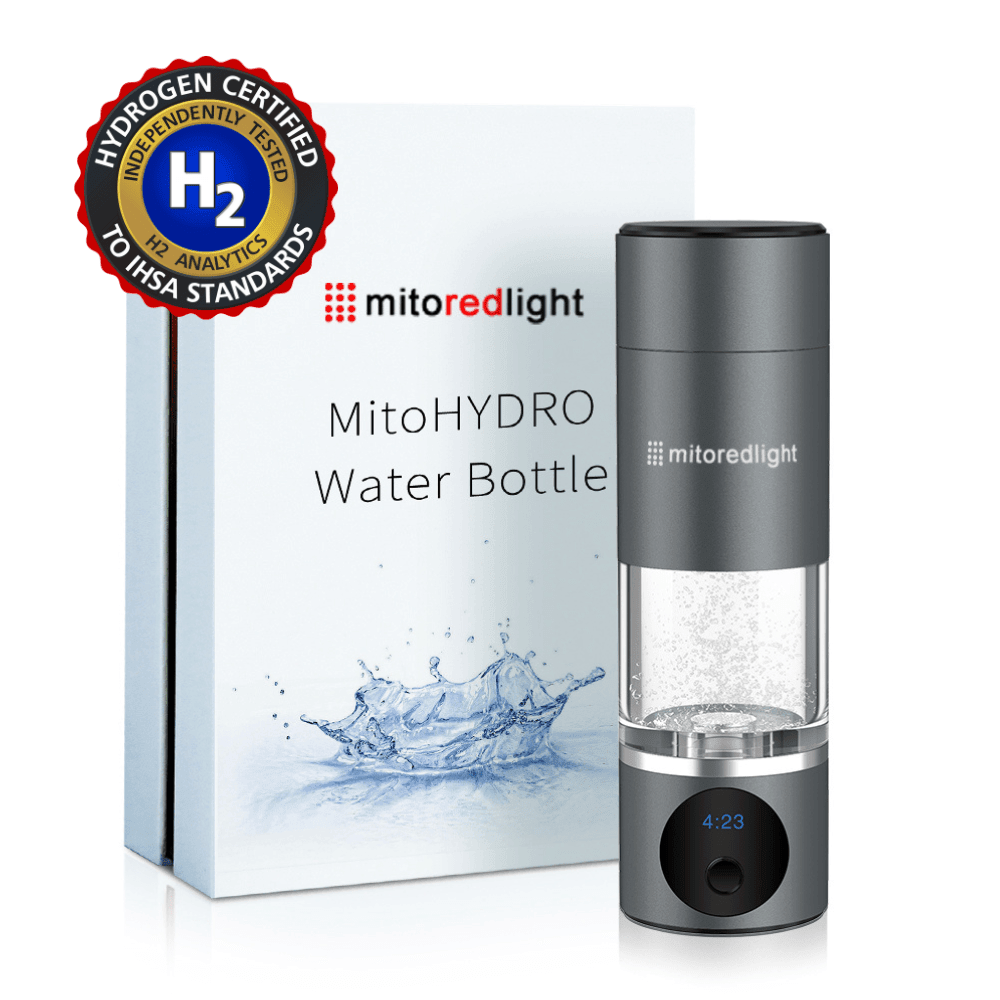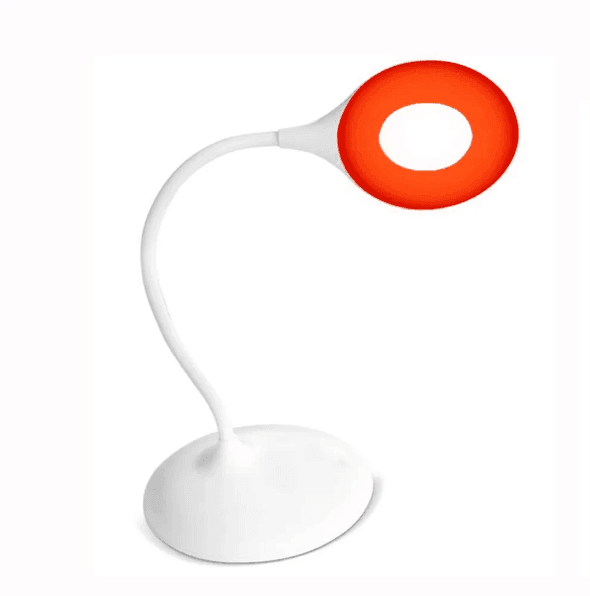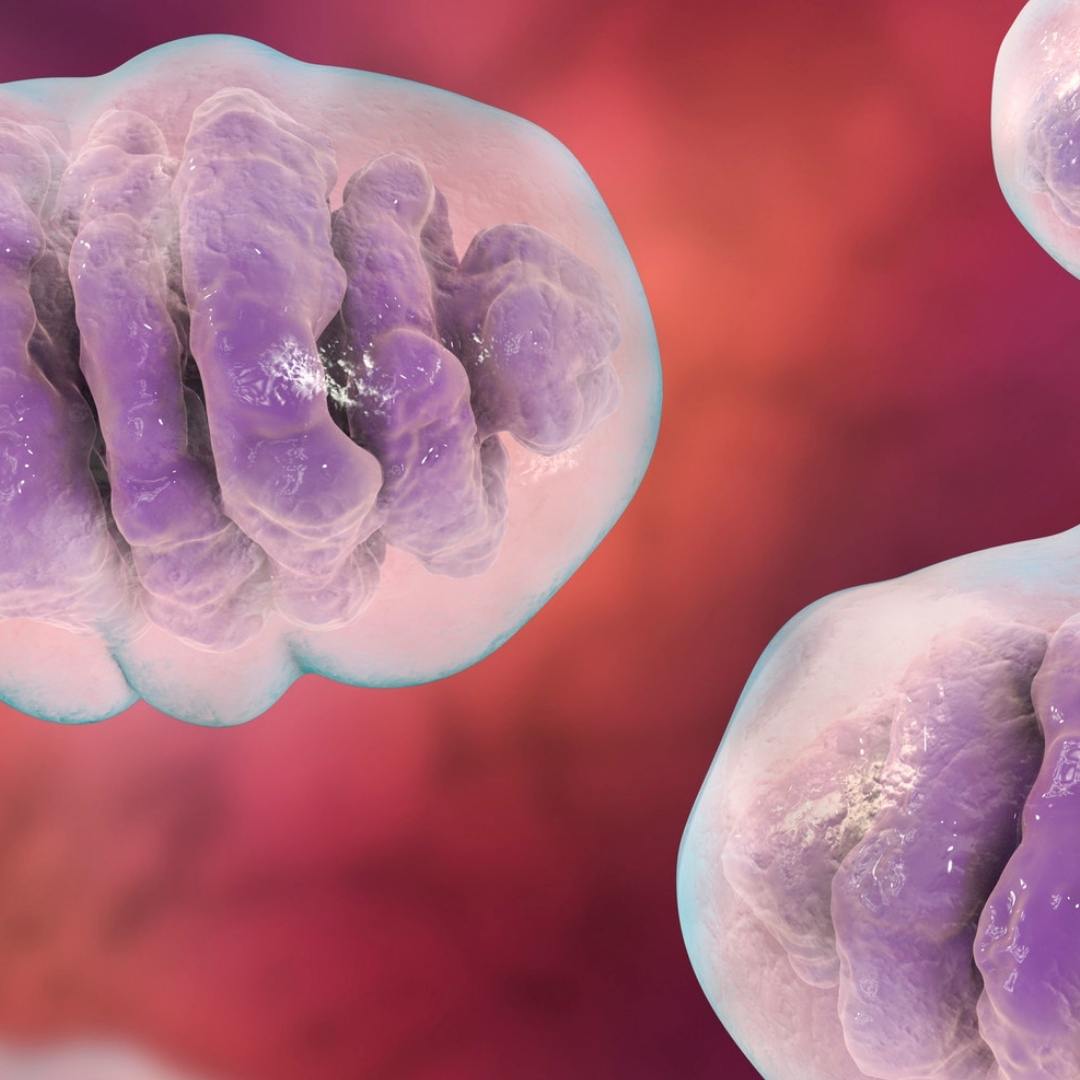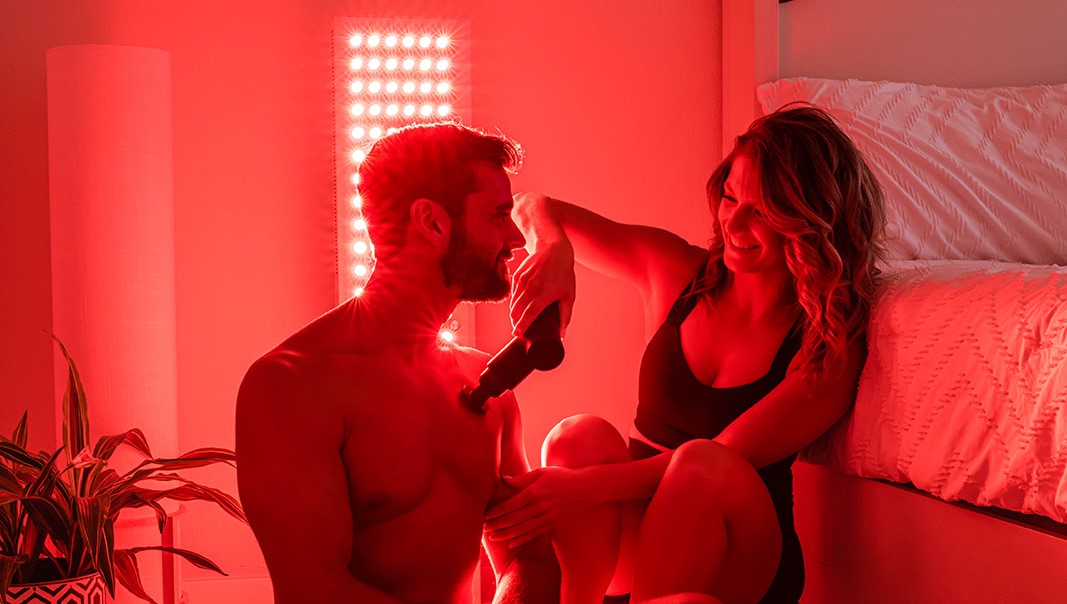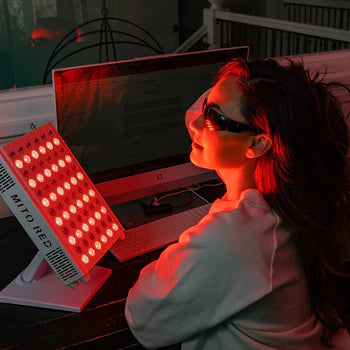DISCLAIMER: Mito Red Light devices are Class II wellness devices aimed at affecting the body through topical heating and supporting cellular function. The information provided in this article and on this site is for educational purposes only and is not intended to imply effectiveness of Mito Red Light devices for any specific application. The information provided in this article and on this site is not intended to diagnose, treat, cure, or prevent any disease, is not a substitute for consultation with a licensed medical provider and should not be construed as medical advice. Click here to read our article on potential contraindications of red light therapy..
Table of Contents
- What is Red Light Therapy?
- Light Therapy?
- How Does Red Light Therapy Work?>
- The History of Red Light Therapy
- Red Light Therapy's Effect on the Skin
- Collagen Production
- Circulation
- Cell Proliferation
- Reduced Inflammation
- What Skin Conditions is Red Light Therapy Used To Treat?
- Wounds
- Psoriasis
- Melasma
- Post-Inflammatory Hyperpigmentation
- Acne
- Scarring
- Age-Related Changes
- How is Red Light Therapy Used?
- Mito Red Light
- References
Red light therapy is an innovative tool that many people are using to treat a variety of different skin issues. While a newer form of therapy, the use of red light therapy to improve skin health and quality has become very popular in mainstream skincare, helping people to achieve their goals for skin health.
People use red light therapy on the skin for a variety of conditions, including:
- Promoting wound healing
- Reducing psoriasis symptoms
- Improving melasma
- Reducing post-inflammatory hyperpigmentation
- Reducing wrinkles and lines
- Improving skin strength and elasticity
- Improving acne
- Improving scarring and stretch marks
- Reducing age spots
While not strictly skin-related, red light therapy is also used to stimulate hair growth on the head or face in those who have areas of low hair density.
What is Red Light Therapy?
Red light therapy is an innovative form of light therapy that has only recently gained mainstream acceptance. This form of therapy uses specific wavelengths of light in the red and infrared spectrum to stimulate biological changes in the body. These changes are thought to cause the skin improvements that people experience when using red light therapy.
Light Therapy
Some scientifically-minded people who are unfamiliar with light therapy may initially be skeptical of the concept of light therapies in general. The idea that simply shining a light on an area of the body could bring about a biological effect may initially sound farfetched; however, there are many good examples of light causing biological changes.
The most striking example of light creating a biological effect is the process of photosynthesis, in which plant cells absorb light and capture its energy, combining carbon dioxide and water to produce oxygen and sugar.
While humans do not use photosynthesis, there are many biological processes where it is well-known and accepted that light influences the body. These include:
- Vitamin D production - Exposure to specific wavelengths of ultraviolet light stimulates the production of vitamin D in skin cells. Vitamin D that is synthesized using the stimulation of sunlight or other light sources containing ultraviolet light is considered to be more effective and more efficient than using vitamin D supplements or eating foods high in vitamin D.
- Melanin production - Ultraviolet light exposure stimulates the production of melanin, the molecule that provides the skin with a darker tone. Increased melanin production is what provides a tan after time out in the sun.
- Bilirubin conjugation - Bilirubin is a chemical byproduct of blood cell breakdown. While in most people, the liver quickly breaks bilirubin down into other chemicals, a process called “conjugation”, very young infants are sometimes unable to conjugate bilirubin, leading it to build up into toxic levels. Ultraviolet light can be used to conjugate bilirubin in these infants [1], preventing toxicity that can lead to brain damage.
- Sight - For most people, it can be easy to take sight for granted; however, the process of sight is a biological effect caused by light. Light-sensitive cells in the eye undergo a chemical change when exposed to light, causing not only the conscious perception of light but also subconscious processes that regulate the sleep-wake cycle.
The idea that red light therapy creates a biological effect on the body is consistent with centuries of observations about how light has biological effects.
How Does Red Light Therapy Work?
Red light therapy is thought to work by stimulating the mitochondria in your cells. Mitochondria are tiny organs in each of your cells; these subcellular organs are primarily known for being the component of the cell that produces all of the cell’s energy. They do, however, also play an important role in reducing inflammation in the cell and regulating how long the cell lives.
Red light therapy actually uses both red, visible wavelengths of light, and infrared, invisible wavelengths. The specific wavelengths that red light therapy uses are thought to be absorbed by a molecule in the mitochondria called cytochrome C oxidase [2]. This molecule is part of the electron transport chain, a group of molecules that perform a series of chemical reactions that result in energy production in the cell. Stimulating cytochrome C oxidase is likely to improve energy output in cells and may be the primary cause of the benefits of red light therapy.
The History of Red Light Therapy
Light therapy, in general, first gained the attention of medical scientists around 1895, when a Danish doctor named Niels Ryberg Finsen started using light to treat infections [3]. Finsen eventually received one of the first Nobel Prizes in Physiology or Medicine in 1903 for his work.
Research into red light therapy, however, began almost a century later when NASA scientists [4] were conducting research into the use of red wavelengths of light to stimulate plant growth. While the experiment did show improved plant growth, one accidental finding was the scientists who spent significant amounts of time exposed to red light experienced rapid healing of skin injuries that they had experienced.
This discovery led to a separate line of research that resulted in multiple potential benefits being discovered for red light therapy. These potential benefits included not only improved skin health but also showed improved sleep quality, decreased inflammation, and improved muscle recovery.
Red Light Therapy's Effect on the Skin
To fully understand how red light therapy can help to improve the quality and health of your skin, it is essential to first understand the different ways that this form of therapy is thought to actually affect your skin. By knowing what red light therapy can do to your skin and the biological effect it can have, you can better understand how red light therapy could help you achieve your skin health goals..
Collagen Production
Collagen is a molecule that plays an essential role in skin health. Collagen is a connective molecule that helps skin cells adhere to each other and to other tissues, such as the fatty cells under the skin. Collagen not only helps connect cells and tissues but also provides elasticity to the skin, allowing the skin to stretch and avoid injury.
Collagen is naturally produced in the body from nutrients that are found in the diet. The amount of collagen produced, however, begins to slowly decrease for most people when they reach about 20 years of age [5]. The decrease in collagen production is quite gradual, only decreasing by about 1% a year. This effect, however, does compound and cause lower amounts of collagen that become more impactful as we age.
When collagen production is decreased, it ultimately leads the skin to become less elastic and full. This is the cause of wrinkles that develop as we age and “saggy” skin. Low levels of collagen also make the skin more fragile as we age, making it more prone to damage whenever injuries occur.
Research shows [6] that red light therapy may stimulate cells called fibroblasts in your skin. These cells are responsible for the production of collagen, and using real light therapy may encourage increased collagen production. According to Harvard Medical School scientists [7], the effect that red light therapy has on fibroblasts and the collagen levels they produce can help red light therapy improve symptoms of aging.
Circulation
Blood circulation plays an important role in how well wounds and injuries heal. Blood not only brings the oxygen needed for cells to produce the energy needed to proliferate and heal but also brings essential nutrients that serve as the building blocks for new cells and tissues.
Good circulation also helps to fight infection, bringing immune cells to the site of an injury and helping to remove waste and debris. This promotes healing but also reduces pain by reducing the amount of inflammation while encouraging healing at the site of injury.
Red light therapy has been shown to promote the release of a chemical called nitric oxide where it is used. Nitric oxide helps to dilate arteries where it is present, increasing the blood flow to that particular area. The effect that red light therapy has on releasing nitric oxide is thought to be what causes red light therapy to improve circulation [8]. This improved circulation is one of the key benefits red light therapy can provide, likely playing an important role in many of its effects.
Cell Proliferation
Cell proliferation refers to cells reproducing themselves, leading to an increased number of cells. Cell proliferation is an important part of the growth of new tissues and healing. As cells multiply, the body forms new tissues and structures, repairing previously damaged tissues. The rate of cell proliferation is a key part of what influences the rate of healing.
Red light therapy is shown to promote cell proliferation [9], especially in cells that are under stress. This can lead to an improved rate of tissue healing and cause wounds to repair themselves more quickly. The exact mechanism of cell proliferation caused by red light therapy is not known but is likely to be a combination of mitochondrial stimulation and increased circulation.
Reduced Inflammation
Inflammation is a normal part of the body’s response when injured. Inflammation results in an increased flow of blood to an area and increased permeability of the tissues. These effects cause the area to become more reddened and warmer to the touch as increased blood flow results. The increased permeability of the tissues allows immune cells and nutrients to better reach the affected area but also can lead to some swelling at the site of the injury.
The inflammatory response plays an important role in healing. Improved blood flow and increased accessibility of immune cells to the site help the area to heal over a short-term basis. One byproduct of inflammation is pain, which signals your consciousness that there is a problem that needs to be attended to.
While inflammation is essential over a short-term basis, it can be very negative if it becomes chronic. People with chronic inflammatory diseases, like rheumatoid arthritis, will have constant inflammation that causes discomfort and pain but does not actually result in the body repairing itself.
While inflammation can be caused by disease, it can also be caused by injuries that are chronic or take time to heal. Muscle injuries, wounds that become infected, or tears of ligaments or tendons can all cause increased inflammation. This can actually make it more difficult to fully heal, as inflammation is a stage of healing that has to stop before other stages can occur.
While chronic inflammation can inhibit healing, one of the most aggravating things it causes is pain. The swelling that inflammation causes can cause pain to develop and to stay while the swelling and inflammation remain. Chronic inflammation will generally cause chronic pain that is very difficult to treat or manage.
The effect that red light therapy has on the mitochondria has been shown by research to suppress inflammation [10]. This can promote improved healing, allowing the body to progress beyond the initial stages of inflammation and into more advanced healing. Suppressing inflammation also reduces pain, a benefit that many people use red light therapy to achieve.
What Skin Conditions is Red Light Therapy Used To Treat?
Red light therapy is a great option for many different types of skin problems but should not be used for every kind of skin issue. There are several skin conditions, however, that people find red light therapy to be useful in treating. Red light therapy should not be used as an alternative to medical care that your doctor prescribes but as a complementary therapy. You should always seek and follow your doctor’s advice when treating skin conditions.
It is also important to seek medical advice when diagnosing a skin condition. There are many potential causes of skin problems, and only a qualified doctor can diagnose a skin condition or disease. It is important to never attempt to diagnose a skin condition by yourself.
If you have a skin condition that is likely to be helped by red light therapy or for which red light therapy seems to make sense, you do not need a prescription to begin therapy. It is, however, a good idea to make sure that your doctor knows that you are using red light therapy.
Wounds
The initial discovery that red light therapy could have positive medical effects was on wounds. Using red light therapy to treat wounds is one of the oldest uses of this therapy and has been shown to improve the speed of wound healing [11]. Wounds will generally heal on their own without any treatments unless they are severe or infected but can be made to heal more quickly when effective treatments are provided.
Red light therapy is used to improve wound healing time, whether it is an external wound that disrupts your skin or an internal wound that affects muscles or other tissues. Open wounds, however, are important to heal as quickly as possible, as healing prevents infection and other complications from having time to develop. This not only ensures that healing occurs but also helps to reduce the risk of scaring, reinjury, or other complications.
Psoriasis
Psoriasis is a skin condition in which the immune system is thought to trigger skin cells to overproliferate. Psoriasis causes scaly, itchy patches of skin. This can lead to discomfort and irritation of the skin, which is difficult to get rid of. One concern that many people with psoriasis have is its cosmetic effect, as it can cause noticeable, unsightly rashes. The ability to hide these rashes depends primarily on the areas that psoriasis affects.
There are several potential treatments for psoriasis, although none of these treatments is a complete cure for the condition. One of the more commonly used treatments that have been shown to help people with psoriasis is a light therapy using ultraviolet light. The wavelengths of this high-energy form of light therapy reduce the overgrowth of skin cells and improve psoriasis symptoms in the areas that are treated.
Red light therapy can be used by people who have psoriasis but is more likely to improve symptoms of pain and irritation of the skin rather than actually improve the skin lesions themselves. The inflammation and irritation that they cause, however, may be reduced by using red light therapy.
One potential benefit of using red light therapy for psoriasis may be that red light therapy helps to protect the skin against damage from UV light [12]. The UV light used to treat psoriasis can increase the risk of skin cancer eventually developing, and red light therapy could provide a protective effect. The degree to which red light therapy actually provides protection, however, is still the subject of ongoing research.
Melasma
Melasma, also called chloasma or the “mask of pregnancy”, is a common skin problem that causes dark patches to develop on the skin. While pregnancy can increase the risk of melasma developing, it can also develop in non-pregnant women or in men.
Melasma typically occurs on the face and is more common in women or those with darker skin. Hormones, sun exposure, stress, and thyroid disease are all thought to be risk factors for developing melasma. While melasma may disappear on its own, especially if it is related to pregnancy or hormone-based medicines, it may also be permanent and often returns if it disappears on its own.
People often use red light therapy for melasma as a means of improving skin quality and reducing the hyperpigmentation that melasma causes. Studies suggest that red light therapy inhibits an enzyme called tyrosinase [13] that produces melanin, the pigmentation that causes melasma blemishes to develop. Using red light therapy helps to even skin tones and can provide cosmetic improvements for those who have melasma.
Post-Inflammatory Hyperpigmentation
Post-inflammatory hyperpigmentation, also called hypermelanosis, occurs when the body overproduces melanin in the skin after inflammation has occurred. In this condition, inflammation triggers skin cells to increase melanin production, leading to darker skin in the areas that were inflamed.
While post-inflammatory hyperpigmentation does fade on its own, this process may take a couple of years or more. Because post-inflammatory hyperpigmentation leads to discoloration that may be cosmetically undesirable, many people who develop this condition prefer to try methods like red light therapy to speed the process.
Much like in people with melasma, red light therapy is used by those with post-inflammatory hyperpigmentation for the effect that it has on evening skin tone and reducing patchiness caused by excessive melanin production. By suppressing melanin production, red light therapy may improve the discoloration caused by post-inflammatory hyperpigmentation.
Acne

Acne is a skin condition that causes hair follicles to become plugged, leading the pores to become clogged. This leads to the development of whiteheads and blackheads that can become infected or cause scarring. Acne commonly affects the face, creating an obvious cosmetic deficit that can be very undesirable.
Bacterial infections can cause acne; however, the whiteheads and blackheads associated with acne can also be related to many other causes. Light therapy in the form of LED face masks have been studied to treat acne, with both ultraviolet light and red light therapy found to be helpful [14]. Ultraviolet light is thought to provide its benefit by helping to destroy bacteria that may be clogging the pore, while red light therapy is thought to improve healing and reduce the risk of long-term scarring developing.
Scarring
Scars develop when an injury does not heal in a way that returns the skin or affected area to its original appearance. Scars can develop after injuries but can also be a concern after surgery or when stretch marks develop. Scaring is generally a long-term problem that can be permanent if not treated.
Red light therapy may help to reduce the likelihood of scars [15] developing after an injury or may reduce the severity of existing scars. Decreasing inflammation and improving circulation, two effects commonly associated with red light therapy, will help injuries to heal correctly. This reduces the likelihood of scar tissue developing due to impaired healing and increases the chances that full and complete healing will occur.
Several effects connected with red light therapy also help existing scarring to partially or completely heal. Increased collagen production can help damaged skin tissue to regain its elasticity. This can be especially helpful in stretching-related scarring, like stretch marks after pregnancy. Increased circulation and evening skin tone can help scarred areas to heal better, making the skin more even and helping it to appear more consistent with how it appeared before an injury.
Age-Related Changes
As we age, our skin undergoes several changes. Some of these changes are cosmetic, primarily changing how your skin appears. Others are more structural, affecting how your skin functions. Often structural changes will lead to cosmetic changes as they affect the skin’s normal function and increase the risk of damage.
Age-related skin changes have two primary causes. Firstly, there are normal changes that occur with aging. With the skin, decreased collagen production is primarily the cause of these changes, but circulation and hormonal changes may also play a role. Secondly, damage accumulates over time. Whether it is sun exposure, tobacco use, or even injuries, the longer the skin has to accumulate damage, the more changes it will experience.
In addition to age-related changes, as we advance in age, we tend to be on more and more medications. Many medications can affect skin quality and lead to skin damage. While not specifically age-related, the likelihood of this occurring increases as we age.
There are three main age-related changes many people commonly experience as they age. These include:
- Age Spots - Also called liver spots, age spots are more and more common with age. These blemishes are also more common in those with higher amounts of sun exposure throughout their lives. Age spots appear as flat brown, black, or tan spots on the skin.
- Wrinkles - As collagen is less abundant, the skin has less elasticity. This leads to the skin being less able to hold its shape and causes wrinkles to occur. Wrinkles begin developing in areas of the skin that are commonly creased but eventually become widespread.
- Fragility - As the skin loses its elasticity and ability to maintain its shape, it becomes more fragile. The decreased connectivity between skin cells and other cells makes it easier for the skin to tear or separate from other layers of tissue.
Red light therapy is used to reduce age-related changes in the skin by stimulating collagen production and evening skin tones. Helping skin tones to become more even by inhibiting excessive melanin production will help age spots to fade. Increased collagen production helps the skin to be more robust and to have fewer wrinkles
@mitoredlightofficial Hey, skincare fanatics! 🧖🏻♀️ Adding Red Light Therapy to your routine is a total game-changer! #MitoRedLight #RedLightTherapy #HealthyLifestyleTips #LightTherapy #HealthyLifestyle ♬ Midnight - Prod. By Rose
More Research On Red Light Therapy for Skin Health
Beyond the research that we’ve already discussed specific to different skin conditions, there is a much larger body of research supporting the benefits of using red light therapy to promote skin health and well-being.
Studies on Red Light Therapy for Skin
Skin-related studies exploring red light therapy can be in vivo, performed in humans, but are also often in vitro, performed in a lab environment on cells taken from humans or animals. Skin cells are particularly suited to in vitro studies, providing greater insights into what biological effects are actually happening.
In Vitro Studies
In 2015, researchers performed an in vitro study [16] by exposing cultured human cells to red LED lights. The results were published in the International Journal of Photoenergy and showed that exposure to 660 nm red light increased the rate at which skin cells multiplied and helped to improve their migration.
A Journal of Wound Management and Research article [17] published in 2018 also tested the effects of light on cultured skin cells. The researchers found that red light or red light combined with infrared light “could modulate fibroblast proliferation and collagen synthesis”. They also determined that combining red light and infrared light produced better results than red light alone.
In 2019 the Journal of the American Academy of Dermatology published research [18] that found that treating skin cells with low-level red and infrared LED lights “significantly increase hyaluronic acid synthase (HAS2) and elastin (ELN) gene expression.” These genes relate to the production of hyaluronic acid and elastin, two molecules that play an important role in keeping your skin hydrated, supple, and elastic and that decrease as we age. The researchers found that these effects occurred in as little as three days. The researchers noted, “Since low level red and infrared light stimulated the production of multiple biomarkers associated with antiaging skin benefits, these findings suggest that low-level red and infrared light treatments present opportunities for daily, at-home treatments for patients with photoaging and photodamaged skin.”
Another study [19] was also published in 2019, examining the effects of red light therapy on skin healing. Published in PLOS One, this study used in vitro porcine (pig) skin that the researchers could damage, then examine its recovery when exposed to light. The researchers found that the use of red light for at least 10 minutes accelerated the recovery of the samples, while blue and purple light did not.
In 2021, a study [20] published in the International Journal of Cosmetic Science found that using red light or infrared light to treat cultured human skin cells increased the expression of four different genes associated with skin health, increased collagen production, increased elastin production, and improved the connectivity of proteins in the skin. The study also found increased production of ATP, the molecule used by the cells for energy, when red light and infrared light were combined.
One very interesting study [21] published in Frontiers in Oncology in 2022 showed that red light used on melanoma cells, cells from a certain type of skin cancer, “prevented tumor growth and increased the expression of immune markers.” These results are very early and do not mean that red light therapy should be used to treat skin cancer; however, they do indicate that future research into this possibility is warranted.
A 2023 study [22] published in Lasers in Medical Science studied human skin cell cultures exposed to 661nm (red) light. The study showed that not only did skin cell cultures heal more quickly when exposed to this light, but that the healing was in part due to an effect that resulted in the cells orienting themselves more effectively and moving to the areas where they were needed.
In Vivo Studies
A 2014 study [23] published in the Journal of Clinical and Experimental Dermatology Research followed 29 patients who underwent broadband infrared therapy once a month for five months. Following these treatments, 76% of the test subjects reported they were satisfied to very satisfied with the treatments. Outcomes measured included wrinkle grades in the tested area, wrinkles at the corners of the eyes, and laxity of the cheek skin, with over three-quarters of the test participants noting changes in each of these measures.
One very important study [24] was published in 2020 in the Journal of Biophotonics. This study examined the safety profiles of red light therapy, testing the effects of red light therapy on a diverse group of 155 people. The study noted specific differences in how safe red light therapy was in people with differences in skin pigmentation. Specifically, they found that red light therapy was “safe up to 320 J/cm2 for skin of color and 480 J/cm2 for non-Hispanic Caucasian individuals.” This finding indicates that those with darker skin pigmentation may both absorb more red light and be more susceptible to dose-related complications from red light therapy.
A controlled study [25] in 2020 was published in the BMJ Open and examined the effects of using high-intensity red light to treat chronic wounds. The study included 60 people and found that using the therapeutic effects of using the treatment on chronic wounds that healed poorly “are significant and far more superior to those of conventional wound dressing.”
Reviews on Red Light Therapy for Skin
In addition to many stand-alone studies demonstrating the benefits of red light therapy for skin health, there are several important reviews. These reviews pull together data from many studies, helping to better contextualize research that has been performed and its implications. Reviews also play an important role in suggesting potential new avenues of research, protocols, and ways to strengthen existing research.
Some recent important reviews for the state of red light therapy research specifically relating to skin health include:
- A 2013 review [26] published in Seminars in Cutaneous Medicine and Surgery. The review found that red light therapy “appears to have a wide range of applications in dermatology, especially in indications where stimulation of healing, reduction of inflammation, reduction of cell death, and skin rejuvenation are required.” The review also noted that it could reduce damage caused by ultraviolet light, both by preventing it and treating it afterward. This review occurred prior to the widespread use of red light therapy in dermatology and likely played a role in its widespread adoption.
- A 2015 review [27] published in the Biomedical and Pharmacology Journal. This review analyzed the different methods of applying red light therapy as well as different potential explanations for how red light therapy actually works. The study helped to clarify how red light therapy impacted healing and noted that more research was needed to determine the parameters that should be used for administering red light therapy.
- A 2016 review [28] published in Wound Healing. This study reviewed red light therapy protocols and noted an increased clinical use of red light therapy to treat wounds and ulcers. The study also reviewed how experiments have confirmed the potential beneficial effects of red light therapy for wound healing.
- A 2018 review [29] published in Lasers in Medical Science. The review noted that red light therapy “represents the emerging and safest tool for the treatment of many conditions such as skin inflammatory conditions, aging, and disorders linked to hair growth.” The review also noted that red light therapy “has now entered common practice among dermatologists,” but it recommended that further controlled studies be performed to better establish its efficacy.
- Another 2018 review [30] published in Medical Research Archives. This review found that the volume of research into red light therapy for skin care had doubled within the previous eight years. The review explored several benefits of red light therapy that had been studied, including using it to treat cutaneous wounds, erosive mucositis in oncology, leg ulcers, burns, radiodermatitis, acne, and hypertrophic scars. It also noted that red light therapy reduces inflammation following other skin treatments that can cause inflammation. The review also identified several potential new applications in which red light therapy was showing promise. These areas included alopecia, cellulite, and other skin diseases.
- A 2021 review [31] published in the Aesthetic Surgery Journal. This review found that “a reasonable body of clinical trial evidence exists to support the role of low-energy red/near-infrared light as a safe and effective method of skin rejuvenation, treatment of acne vulgaris and alopecia, and, especially, body contouring.” The review also suggested potential methods of improving future studies, such as improving methodologies and the number of patients included in each study.
How is Red Light Therapy Used?
Using red light therapy to improve skin health is relatively straightforward. Before getting started, there are, however, a few steps that you should take:
- Ensure you do not have any contraindications. Not everyone should use red light therapy, and you should make sure there are no reasons that you should not use it. If you are unsure, you should check with your doctor before using it.
- Learn about red light therapy. There can be wide differences in the quality of different red light sources, and there is more to it than just having a light source that is red. Be sure that you understand the quality of the products you will be using.
- Ensure you have access to red light therapy. The changes that red light therapy provides are worth it but tend to be more gradual. To use red light therapy correctly, you will need to have regular access to a red light therapy panel or device.
Once you are ready to begin using red light therapy, actually performing the treatment is quite easy.
- Turn the red light source on.
- Ensure you have protective eyewear on.
- Ensure the area being treated is uncovered.
- Position yourself about 12-16 inches from the source.
- Allow the light source to irradiate the area being treated for 10-20 minutes.
- Repeat regularly, from three to seven times a week.
If the manufacturers of the red light panel or your physician provide different instructions on the timeframe, distance, frequency, or other factors, you should follow their advice.
Mito Red Light
As Mito Red Light, we provide a wide variety of red light therapy products that are designed to deliver specific wavelengths of light that are thought to help improve cellular function of skin cells and thereby improve overall skin health. Our panels are designed to provide the maximum amount of the right light to as much area as possible.
Customer feedback on skin has been outstanding. Check out some red light therapy before and after photos and our growing repository of glowing reviews.
We welcome you to review our selection of high-quality products or to contact one of our expert representatives at +1 866-861-6486 or by email at info@mitoredlight.com.
Related Articles:
- What Is Red and Near Infrared (NIR) Light Therapy?
- Red Light Therapy Buyer’s Guide
- Everything You Need to Know About Red Light Therapy and SKIN
References:
- Woodgate, P., & Jardine, L. A. (2015). Neonatal jaundice: phototherapy. BMJ Clinical Evidence, 2015, 0319. https://www.ncbi.nlm.nih.gov/pmc/articles/PMC4440981/
- Tafur, J., & Mills, P. J. (2008). Low-Intensity Light Therapy: Exploring the Role of Redox Mechanisms. Photomedicine and Laser Surgery, 26(4), 323–328. https://doi.org/10.1089/pho.2007.2184
- Nobel Prize Outreach AB. (2023). The Nobel Prize in Physiology or Medicine 1903. https://www.nobelprize.org/prizes/medicine/1903/summary/
- Cotler, H. B. (2015). A NASA discovery has current applications in orthopaedics. Current Orthopaedic Practice, 26(1), 72–74. https://doi.org/10.1097/BCO.0000000000000196
- Obagi, S. (2005, September 26). Why does skin wrinkle with age? What is the best way to slow or prevent this process? Scientific American. https://www.scientificamerican.com/article/why-does-skin-wrinkle-wit/
- Wunsch, A., & Matuschka, K. (2014). A Controlled Trial to Determine the Efficacy of Red and Near-Infrared Light Treatment in Patient Satisfaction, Reduction of Fine Lines, Wrinkles, Skin Roughness, and Intradermal Collagen Density Increase. Photomedicine and Laser Surgery, 32(2), 93–100. https://doi.org/10.1089/pho.2013.3616
- Harvard Health Publishing. (2019, October 1). LED lights: Are they a cure for your skin woes? https://www.health.harvard.edu/diseases-and-conditions/led-lights-are-they-a-cure-for-your-skin-woes
- Keszler, A., Lindemer, B., Weihrauch, D., Jones, D., Hogg, N., & Lohr, N. L. (2017). Red/Near Infrared Light Stimulates Release of an Endothelium Dependent Vasodilator and Rescues Vascular Dysfunction in a Diabetes Model. Free Radical Biology and Medicine, 113, 157–164. https://doi.org/10.1016/j.freeradbiomed.2017.09.012
- Ayuk, S. M., Houreld, N. N., & Abrahamse, H. (2018). Effect of 660 nm visible red light on cell proliferation and viability in diabetic models in vitro under stressed conditions. Lasers in Medical Science, 33(5), 1085–1093. https://doi.org/10.1007/s10103-017-2432-2
- Hamblin, M. R. (2017). Mechanisms and applications of the anti-inflammatory effects of photobiomodulation. AIMS Biophysics, 4(3), 337–361. https://doi.org/10.3934/biophy.2017.3.337
- Chaves, M. E. A., Araújo, A. R., Piancastelli, A. C. C., & Pinotti, M. (2014). Effects of low-power light therapy on wound healing: LASER x LED. Anais Brasileiros de Dermatologia, 89(4), 616–623. https://doi.org/10.1590/abd1806-4841.20142519
- Barolet, D., Christiaens, F., & Hamblin, M. R. (2016). Infrared and Skin: Friend or Foe. Journal of Photochemistry and Photobiology B: Biology, 155, 78–85. https://doi.org/10.1016/j.jphotobiol.2015.12.014
- Kim, J. M., Kim, N-H., Tian, Y. S., & Lee, A-Y. (2012). Light-emitting diodes at 830 and 850 nm inhibit melanin synthesis in vitro. Acta Dermato-Venereologica, 92, 675–680. https://doi.org/10.2340/00015555-1319
- Pei, S., Inamadar, A. C., Adya, K. A., & Tsoukas, M. M. (2015). Light-based therapies in acne treatment. Indian Dermatology Online Journal, 6(3), 145–157. https://doi.org/10.4103/2229-5178.156379
- Kurtti, A., Nguyen, J. K., Weedon, J., Mamalis, A., Lai, Y., Masub, N., Geisler, A., Siegel, D. M., & Jagdeo, J. R. (2021). Light emitting diode-red light for reduction of post-surgical scarring: Results from a dose-ranging, split-face, randomized controlled trial. Journal of Biophotonics, 14(7), e202100073. https://doi.org/10.1002/jbio.202100073
- Kim, M-S., Cho, Y-I., Kook, M-S., Jung, S-C., Hwang, Y-H., & Kim, B-H. (2015). Effect of 660 nm Light-Emitting Diode on the Wound Healing in Fibroblast-Like Cell Lines. International Journal of Photoenergy, 2015, Article ID 916838. https://doi.org/10.1155/2015/916838
- Ma, H., Yang, J-P., Tan, R. K., Lee, H-W., & Han, S-K. (2018). Effect of Low-Level Laser Therapy on Proliferation and Collagen Synthesis of Human Fibroblasts in Vitro. Journal of Wound Management and Research, 14(1), 1-6. https://doi.org/10.22467/jwmr.2018.00283
- Kim, B., Mukherjee, A., Seo, I., Fassih, A., Southall, M., & Parsa, R. (2019). Low-level red and infrared light increases expression of collagen, elastin, and hyaluronic acid in skin. Journal of the American Academy of Dermatology, 81(4), AB434. https://doi.org/10.1016/j.jaad.2019.10.089
- Abe, Y., Konno, H., Yoshida, S., Yamauchi, T., Yamasaki, K., Denda, M., & Nishizawa, M. (2019). Red light-promoted skin barrier recovery: Spatiotemporal evaluation by transepidermal potential. PLOS ONE, 14(7), e0219198. https://doi.org/10.1371/journal.pone.0219198
- 11. Li, W.-H., Seo, I., Kim, B., Fassih, A., Southall, M. D., & Parsa, R. (2021). Low-level red plus near infrared lights combination induces expressions of collagen and elastin in human skin in vitro. International Journal of Cosmetic Science, 43(3), 311-320. https://doi.org/10.1111/ics.12698
- Austin, E., Huang, A., Wang, J. Y., Cohen, M., Heilman, E., Maverakis, E., Michl, J., & Jagdeo, J. (2022). Red Light Phototherapy Using Light-Emitting Diodes Inhibits Melanoma Proliferation and Alters Tumor Microenvironments. Frontiers in Oncology, 12. https://doi.org/10.3389/fonc.2022.928484
- Giannakopoulos, E., Katopodi, A., Rallis, M., Politopoulos, K., & Alexandratou, E. (2023). The effects of low power laser light at 661 nm on wound healing in a scratch assay fibroblast model. Lasers in Medical Science, 38(1), 27. https://doi.org/10.1007/s10103-022-03670-5
- Hirao, A., Morita, R., & Kawada, A. (2014). Clinical Effectiveness of Broad-band Infrared Light Therapy for Wrinkles and Skin Laxity of the Face. Journal of Clinical and Experimental Dermatological Research, 5(5). https://doi.org/10.4172/2155-9554.1000233
- Jagdeo, J., Nguyen, J. K., Ho, D., Wang, E. B., Austin, E., Mamalis, A., Kaur, R., Kraeva, E., Schulman, J. M., Li, C.-S., Hwang, S. T., Wun, T., Maverakis, E., & Isseroff, R. R. (2020). Safety of light emitting diode-red light on human skin: two randomized controlled trials. Journal of Biophotonics, 13(3), e201960014. https://doi.org/10.1002/jbio.201960014
- Lu, Q., Yin, Z., Shen, X., Li, J., Su, P., Feng, M., Xu, X., Li, W., He, C., & Shen, Y. (2021). Clinical effects of high-intensity laser therapy on patients with chronic refractory wounds: a randomised controlled trial. BMJ Open, 11, e045866. https://doi.org/10.1136/bmjopen-2020-045866
- Avci, P., Gupta, A., Sadasivam, M., Vecchio, D., Pam, Z., Pam, N., & Hamblin, M. R. (2013). Low-Level Laser (Light) Therapy (LLLT) in Skin: Stimulating, Healing, Restoring. Seminars in Cutaneous Medicine and Surgery, 32, 41-52. https://scmsjournal.com/articles/view_pdf/low-level-laser-light-therapy-lllt-in-skin-stimulating-healing-restoring
- Rashidi, S., Yadollahpour, A., & Mirzaiyan, M. (2015). Low Level Laser Therapy for the Treatment of Chronic Wound: Clinical Considerations. Biomedical and Pharmacology Journal, 8(2). https://dx.doi.org/10.13005/bpj/866
- Bayat, M. (2016). The Need for Increased Attention to Low‐Level Laser Therapy as Treatment for Wounds and Ulcers. In Wound Healing - New insights into Ancient Challenges. https://doi.org/10.5772/64339
- Sorbellini, E., Rucco, M., & Rinaldi, F. (2018). Photodynamic and photobiological effects of light-emitting diode (LED) therapy in dermatological disease: an update. Lasers in Medical Science, 33, 1431–1439. https://doi.org/10.1007/s10103-018-2584-8
- Barolet, D. (2018). Photobiomodulation in Dermatology: Harnessing Light from Visible to Near Infrared for Medical and Aesthetic Purposes. Medical Research Archives, 6(1). https://esmed.org/MRA/mra/article/view/1610/1689
- Glass, G. E. (2021). Photobiomodulation: The Clinical Applications of Low-Level Light Therapy. Aesthetic Surgery Journal, 41(6), 723–738. https://doi.org/10.1093/asj/sjab025
